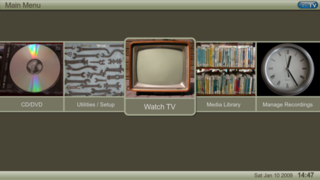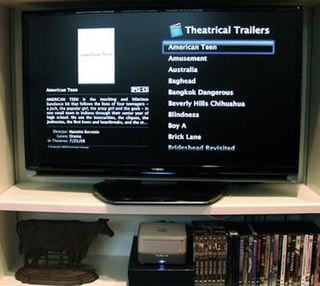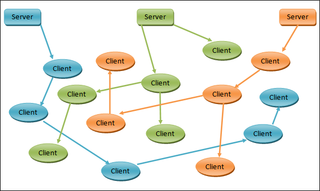Related Research Articles

A set-top box (STB), also known as a cable box, receiver, or simply box, and historically television decoder or a converter, is an information appliance device that generally contains a TV tuner input and displays output to a television set, turning the source signal into content in a form that can then be displayed on the television screen or other display device. It is designed to be placed alongside or "on top" of a television set.

TiVo is a digital video recorder (DVR) developed and marketed by Xperi and introduced in 1999. TiVo provides an on-screen guide of scheduled broadcast programming television programs, whose features include "OnePass" schedules which record every new episode of a series, and "WishList" searches which allow the user to find and record shows that match their interests by title, actor, director, category, or keyword. TiVo also provides a range of features when the TiVo DVR is connected to a home network, including film and TV show downloads, advanced search, online scheduling, and at one time, personal photo viewing and local music playback.
A digital video recorder (DVR), also referred to as a personal video recorder (PVR) particularly in Canada and British English, is an electronic device that records video in a digital format to a disk drive, USB flash drive, SD memory card, SSD or other local or networked mass storage device. The term includes set-top boxes (STB) with direct to disk recording, portable media players and TV gateways with recording capability, and digital camcorders. Personal computers are often connected to video capture devices and used as DVRs; in such cases the application software used to record video is an integral part of the DVR. Many DVRs are classified as consumer electronic devices. Similar small devices with built-in displays and SSD support may be used for professional film or video production, as these recorders often do not have the limitations that built-in recorders in cameras have, offering wider codec support, the removal of recording time limitations and higher bitrates.

MythTV is a free and open-source home entertainment application with a simplified "10-foot user interface" design for the living room TV. It turns a computer with the necessary hardware into a network streaming digital video recorder, a digital multimedia home entertainment system, or home theater personal computer. It can be considered a free and open-source alternative to TiVo or Windows Media Center. It runs on various operating systems, primarily Linux, macOS, and FreeBSD.

A home theater PC (HTPC) or media center computer is a convergent device that combines some or all the capabilities of a personal computer with a software application that focuses on video, photo, audio playback, and sometimes video recording functionality. Since the mid-2000s, other types of consumer electronics, including game consoles and dedicated media devices, have crossed over to manage video and music content. The term "media center" also refers to specialized application software designed to run on standard personal computers.

Hauppauge Computer Works is a US manufacturer and marketer of electronic video hardware for personal computers. Although it is most widely known for its WinTV line of TV tuner cards for PCs, Hauppauge also produces personal video recorders, digital video editors, digital media players, hybrid video recorders and digital television products for both Windows and Mac. The company is named after the hamlet of Hauppauge, New York, in which it is based.

MediaPortal is an open-source media player and digital video recorder software project, often considered an alternative to Windows Media Center. It provides a 10-foot user interface for performing typical PVR/TiVo functionality, including playing, pausing, and recording live TV; playing DVDs, videos, and music; viewing pictures; and other functions. Plugins allow it to perform additional tasks, such as watching online video, listening to music from online services such as Last.fm, and launching other applications such as games. It interfaces with the hardware commonly found in HTPCs, such as TV tuners, infrared receivers, and LCD displays.

P2PTV refers to peer-to-peer (P2P) software applications designed to redistribute video streams in real time on a P2P network; the distributed video streams are typically TV channels from all over the world but may also come from other sources. The draw to these applications is significant because they have the potential to make any TV channel globally available by any individual feeding the stream into the network where each peer joining to watch the video is a relay to other peer viewers, allowing a scalable distribution among a large audience with no incremental cost for the source.

Windows Media Center (WMC) is a digital video recorder and media player created by Microsoft. Media Center was first introduced to Windows in 2002 on Windows XP Media Center Edition (MCE). It was included in Home Premium and Ultimate editions of Windows Vista, as well as all editions of Windows 7 except Starter and Home Basic. It was also available on Windows 8 Pro and Windows 8.1 Pro as a paid add-on. It was discontinued as of Windows 10 and the operating system also removes all of Windows Media Center during an upgrade from previous versions of Windows, although it can reportedly be unofficially reinstalled using a series of Command Prompt commands.

SageTV Media Center, now open source, was a proprietary, commercial DVR and HTPC software for Mac OS X, Windows and Linux. It requires that the host computer have a hardware-based TV tuner card. The SageTV software has an integrated Electronic Programming Guide (EPG) that is updated via the Internet. The program provides a television interface for DVR, music, and photos on Windows and Linux. SageTV Media Center typically records in standard MPEG2, making it possible to transfer recordings to laptops or other devices. It also has a built-in conversion feature to transcode files into other formats compatible with iPod, PSP, cell phones and other portable devices.
Guide Plus+, TV Guide On Screen, TV Guide Daily, TV Guide Plus+ and Guide Plus+ Gold or G-Guide are brand names for an interactive electronic program guide (EPG) system that is used in consumer electronics products, such as television sets, DVD recorders, personal video recorders, and other digital television devices. It offers interactive on-screen program listings that enable viewers to navigate, sort, select and schedule television programming for viewing and recording. The differing names are only used for marketing purposes – the entire system is owned by Rovi Corporation, the successor to Gemstar-TV Guide International. In 2016, Rovi acquired digital video recorder maker TiVo Inc., and renamed itself TiVo Corporation.
Orb was a freeware streaming software that enabled users to remotely access all their personal digital media files including pictures, music, videos and television. It could be used from any Internet-enabled device, including laptops, pocket PC, smartphones, PS3, Xbox 360 and Wii video game consoles.

EyeTV is a European brand of TV tuners that allow users to watch TV on various devices including computers and smartphones. The brand was introduced in 2002 by Elgato Systems and was sold to Geniatech in 2016.
This is a comparison of digital video recorder (DVR), also known as personal video recorder (PVR), software packages. Note: this is may be considered a comparison of DVB software, not all listed packages have recording capabilities.

GB-PVR was a PVR application, running on Microsoft Windows, whose main function was scheduling TV recordings and playing back live TV. GB-PVR is no longer under active development and has been superseded by NextPVR, also known as nPVR.
The Archos Generation 6 (Gen6) product series is represented by misc "Internet Media Tablets" or "IMT", e.g. the Archos 5 Internet Media Tablet This series of tablet computers developed by the French company Archos that features a resistive touchscreen for video, photo, audio, internet browsing and other multimedia applications. The individual numbering of the distinct models seems up to now to roughly resemble the length of the display diagonal in inches.

HP TouchSmart is a series of tablet PC laptops and touchscreen all-in-one desktop computers designed by HP. It features various Intel or AMD processors and runs Windows Vista or Windows 7 as standard.

A smart TV, also known as a connected TV (CTV), is a traditional television set with integrated Internet and interactive Web 2.0 features that allow users to stream music and videos, browse the internet, and view photos. Smart TVs are a technological convergence of computers, televisions, and digital media players. Besides the traditional functions of television sets provided through traditional broadcasting media, these devices can provide access to over-the-top media services such as streaming television and internet radio, along with home networking access.

DVBViewer is proprietary, commercial software for viewing & recording of DVB TV & Radio using a TV tuner card or box and a Media Center for viewing Music, Video and Pictures. Among its other features are an Electronic Program Guide (EPG), remote control support, on-screen display, teletext, time shifting and picture-in-picture. Besides the support for BDA adapters, there is also the ability to use the Hauppauge MediaMVP with DVBViewer. The software also allows Unicable, DiSEqC and usage of CI-Modules with most adapters. The worldwide charge for the application is 15 euro or 22 US Dollars. Additional functions such as video on demand, TV series and movie management, home network distribution of TV to network devices including iPod Touch, iPhone & iPad & Android devices, and a recording service with web interface are provided by free plugins. A plug-in offering MHEG-5 and HbbTV support is available for a license fee of 12 euros.
References
- ↑ "Intercast", The Free Dictionary, retrieved 2019-07-01
- ↑ Stellin, Susan (1997-04-04). "features - techno - Intercasting". CNET. Archived from the original on 1997-01-19. Retrieved 2019-07-01.
- ↑ Crothers, Brooke (1996-07-01). "Hauppauge offering card for Intercast". CNET. Retrieved 2019-07-01.
- ↑ Lemos, Robert (1996-01-16). "Interactive TV primer". ZDNet. Retrieved 2019-07-01.
- ↑ Crothers, Brooke. "Intel, NBC to cover Olympics on PC-TV". CNET. Retrieved 2019-06-30.
